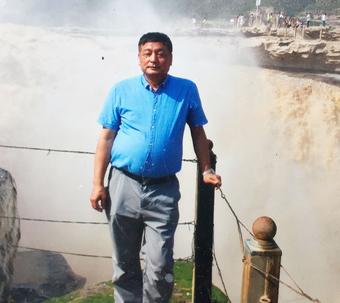Danyang Mounting Association
Danyang Mounting Association
Personal Profile
Danyang has a long history of painting and calligraphy mounting. According to research, the prosperity of Danyang's mounting industry originated from its profound historical and cultural heritage. Danyang is rich in talents, with many famous people emerging since ancient times, including a large number of literary figures, painters, and collectors. In the circle of painting and calligraphy related to mounting, there have been many famous people in Danyang's history. For example, Wu Shu of the Song Dynasty, Pan Feng, Jiang Shoucheng, and Guo Yingzhi of the Ming Dynasty, and Jiang Wizhan, Jiang Qing, Tang Zhouding, Ma Jiajun, Ding Gao, and Shu Nanji of the Qing Dynasty, as well as Guo Songru and Yin Songnian of the Republic of China, and Lü Fengzi and Gu Liancun of modern times.
After the Ming and Qing Dynasties, due to differences in styles, patterns, and craftsmanship in painting and calligraphy mounting across different regions, the mounting culture in each area developed strong regional aesthetic characteristics, each with its own strengths. The art of painting and calligraphy mounting was generally divided into four major schools: Suzhou (Su), Shanghai (Shang), Yangzhou (Yang), and Beijing (Jing). Among them, the Suzhou mounting art was renowned nationwide and known as "Wu Zhuang." The characteristics of the Su school include flat, soft mounting pieces, simple and elegant color schemes, classic and harmonious aesthetics, precise and appropriate mounting, and effective restoration techniques. The craftsmanship was exquisite, and the Ming Dynasty scholar Hu Yinglin's "The Notes from the Small Treasure Mountain House" highly praised it, saying "Wu mounting is the best, other places cannot match it," and it had an important influence on the mounting styles of other regions. Danyang's mounting art belongs to the Su school. Its history is relatively long, and as early as the Qing Dynasty, Danyang's mounting art had already gained fame.清朝同治、光绪年间,丹阳西门外马陵洪家村洪授清在苏州学习装裱手艺,逐渐成为清朝光绪年间著名的“苏裱”师傅,专裱宋元精英书画,首开古字画修补之先河,为提高我国装裱技艺,为中国古书画艺术做出了极大的贡献。当时上海新闻报以及东京伦敦等地的报纸都报道过他的精湛技艺。受父亲的影响,洪授清的儿子洪秋声16岁就继承父业远离家乡,只身到苏州学习苏裱技艺。在上海“翰墨林装池”打过工,在苏州开过“宝古山房”裱画店。解放后到故宫博物院从事古字画修复。上世纪五十年代,因安徽省博物馆古字画修复人员匮缺,洪秋声来到安徽省博物馆。经过他抢救的古代珍贵字画,就有数百件之多。洪秋声为了我国的文物保护事业奋斗了整整七十个春秋,默默无闻地献出了自己毕生的心血。古字画的揭裱是苏裱的一大特点,洪秋声作为苏裱的传人,抢救了许多濒于灭绝的国宝。其中包括1977年成功揭裱江苏溧阳发掘的一座宋朝墓葬中出土的宋人用白金手抄的《金刚经》。
民国时期,河阳魏家村魏三春马陵村的窦祥云 窦治荣与同乡洪秋声,陈广忠、尹炳海都在上海从事装裱工作。窦祥云,窦治荣与洪秋声在上海跑马场最有名的刘定之装裱店当装裱师,当时上海的许多著名书画家和收藏家都来此装裱字画。解放后,洪秋声到安徽省博物馆工作并获得安徽非物质文化遗产传承人,窦祥云 窦治荣和陈广忠等在上海博物馆工作。
改革开放后,丹阳书画修复装裱事业在窦祥云 窦治荣等前辈的大力推动下,得到了蓬勃发展,窦祥云窦治荣及陈广忠和魏山泉在上海回乡创办了丹阳河阳工艺美术厂后原河阳镇成为全国著名的“装裱之乡”,水湖村社上自然村是著名的装裱村,村上有许多人在外地以书画装裱为主要职业。现有大批人员在上海、北京、天津、广州、杭州、济南、淄博、太原、南昌等地从事装裱工作。丹阳装裱技术经过几代人的相传和发展,到如今已经是技术纯熟,经验丰富,形成了做工精细,用料考究,大方得体,集南北装裱风格之特长于一体的风格。现今,丹阳书画装裱业人才辈出,遍布全国各地,业已形成“丹阳人裱画”群体,受到业界人士的尊重和书画界人士的广泛赞誉。主要代表性人物是清末民国时期的陈广忠、洪授清、洪秋声父子和窦祥云 窦治荣和陈广忠及等以及现当代的其传人夏炎,吴林泉,戴伟云,沈银根,周义军,魏六海,吴兴海,魏星海,吕荣义等。 National mounting looks to Danyang, and Danyang mounting looks to Heyang. The personnel who have gone out from Danyang and Heyang are now very famous all over the country, and have established the brand of "Danyang Mounting."
After the Ming and Qing Dynasties, due to differences in styles, patterns, and craftsmanship in painting and calligraphy mounting across different regions, the mounting culture in each area developed strong regional aesthetic characteristics, each with its own strengths. The art of painting and calligraphy mounting was generally divided into four major schools: Suzhou (Su), Shanghai (Shang), Yangzhou (Yang), and Beijing (Jing). Among them, the Suzhou mounting art was renowned nationwide and known as "Wu Zhuang." The characteristics of the Su school include flat, soft mounting pieces, simple and elegant color schemes, classic and harmonious aesthetics, precise and appropriate mounting, and effective restoration techniques. The craftsmanship was exquisite, and the Ming Dynasty scholar Hu Yinglin's "The Notes from the Small Treasure Mountain House" highly praised it, saying "Wu mounting is the best, other places cannot match it," and it had an important influence on the mounting styles of other regions. Danyang's mounting art belongs to the Su school. Its history is relatively long, and as early as the Qing Dynasty, Danyang's mounting art had already gained fame.清朝同治、光绪年间,丹阳西门外马陵洪家村洪授清在苏州学习装裱手艺,逐渐成为清朝光绪年间著名的“苏裱”师傅,专裱宋元精英书画,首开古字画修补之先河,为提高我国装裱技艺,为中国古书画艺术做出了极大的贡献。当时上海新闻报以及东京伦敦等地的报纸都报道过他的精湛技艺。受父亲的影响,洪授清的儿子洪秋声16岁就继承父业远离家乡,只身到苏州学习苏裱技艺。在上海“翰墨林装池”打过工,在苏州开过“宝古山房”裱画店。解放后到故宫博物院从事古字画修复。上世纪五十年代,因安徽省博物馆古字画修复人员匮缺,洪秋声来到安徽省博物馆。经过他抢救的古代珍贵字画,就有数百件之多。洪秋声为了我国的文物保护事业奋斗了整整七十个春秋,默默无闻地献出了自己毕生的心血。古字画的揭裱是苏裱的一大特点,洪秋声作为苏裱的传人,抢救了许多濒于灭绝的国宝。其中包括1977年成功揭裱江苏溧阳发掘的一座宋朝墓葬中出土的宋人用白金手抄的《金刚经》。
民国时期,河阳魏家村魏三春马陵村的窦祥云 窦治荣与同乡洪秋声,陈广忠、尹炳海都在上海从事装裱工作。窦祥云,窦治荣与洪秋声在上海跑马场最有名的刘定之装裱店当装裱师,当时上海的许多著名书画家和收藏家都来此装裱字画。解放后,洪秋声到安徽省博物馆工作并获得安徽非物质文化遗产传承人,窦祥云 窦治荣和陈广忠等在上海博物馆工作。
改革开放后,丹阳书画修复装裱事业在窦祥云 窦治荣等前辈的大力推动下,得到了蓬勃发展,窦祥云窦治荣及陈广忠和魏山泉在上海回乡创办了丹阳河阳工艺美术厂后原河阳镇成为全国著名的“装裱之乡”,水湖村社上自然村是著名的装裱村,村上有许多人在外地以书画装裱为主要职业。现有大批人员在上海、北京、天津、广州、杭州、济南、淄博、太原、南昌等地从事装裱工作。丹阳装裱技术经过几代人的相传和发展,到如今已经是技术纯熟,经验丰富,形成了做工精细,用料考究,大方得体,集南北装裱风格之特长于一体的风格。现今,丹阳书画装裱业人才辈出,遍布全国各地,业已形成“丹阳人裱画”群体,受到业界人士的尊重和书画界人士的广泛赞誉。主要代表性人物是清末民国时期的陈广忠、洪授清、洪秋声父子和窦祥云 窦治荣和陈广忠及等以及现当代的其传人夏炎,吴林泉,戴伟云,沈银根,周义军,魏六海,吴兴海,魏星海,吕荣义等。 National mounting looks to Danyang, and Danyang mounting looks to Heyang. The personnel who have gone out from Danyang and Heyang are now very famous all over the country, and have established the brand of "Danyang Mounting."
para-title
TAG:
Danyang Mounting Association

 中文
中文  en
en 
